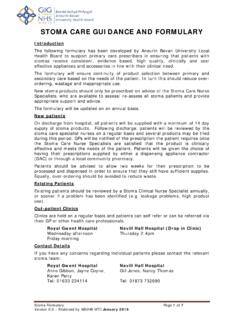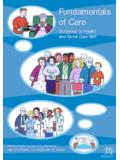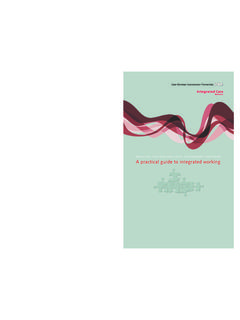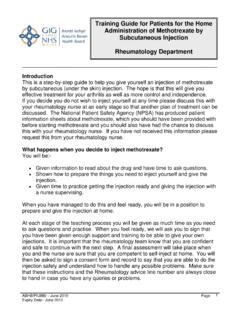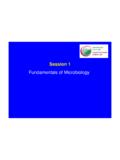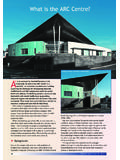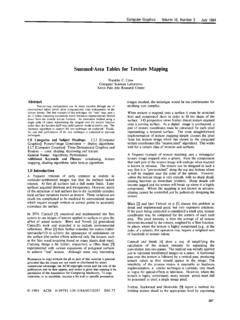Transcription of dysphagia Texture D - NHS Wales
1 1 Department of Nutrition and Dietetics Department of Speech and Language Therapy Texture D Diet (Pureed meat and mashed vegetables) This leaflet has been produced with the help of patients This leaflet is available in other languages and formats, eg CD, just ask. Patient Name: _____ Assessed/ Recommended by: Name: _____ Profession: _____ Telephone: _____ Date issued: _____ Why do I need a different diet Texture ? 2 Difficulty in swallowing, also known as dysphagia , is a condition which makes it difficult for some people to eat and drink. The muscles in your mouth and throat are weakened and as a result you may not be able to move food and liquid around your mouth and swallow it as you normally would.
2 As a result, the food may go down into your lungs and cause infection. Changing the Texture of your food can make it easier and safer for you to swallow. You have been assessed you and it has been recommended that you have a Texture D diet. This leaflet is a guide to help you prepare your food to the right consistency. What is Texture D? Texture D is a very soft and moist consistency and if needed can be served coated with a sauce. It has some variation in Texture , similar to flaked fish in thick sauce or stewed apple and thick custard. Food requires little chewing and can be easily mashed and eaten with a fork. How do I prepare my foods for a Texture D diet? Foods should be cooked until soft. It may be necessary to add a sauce or gravy to ensure the food is moist enough.
3 Meat may cause a problem if it is tough or in large lumps. Meat should be pureed with an electric blender or liquidiser. All other food items should be well mashed and moist. Freeze extra meals: Allow to cool, cover, label and freeze quickly. Allow to thaw completely before re-heating. Re-heat foods until piping hot and allow to cool to the heat you prefer. The flavour of food can be diluted when you add extra sauce or gravy; try adding more seasoning, such as salt, pepper, herbs and spices, once food has been blended / liquidised. To thicken foods Try adding corn flour, instant mash, instant sauce mix, packet soups or custard powder. 3 What about my medication? The Texture of your medications may also need to be changed.
4 Some medications are available in syrup as well as tablet form. Some can be crushed and mixed with food to make them easier to swallow. It is essential that you ask your GP or pharmacist before changing how you take your medications. What about cleaning my teeth? It is important to brush your teeth, tongue and gums at least twice a day; especially after meals. Swallowing saliva containing bacteria from the mouth can lead to chest infections. You are advised to use a low foaming toothpaste ( Sensodyne or Biotene) as this does not stimulate excess saliva or leave the mouth dry. Put a pea-sized amount onto the bristles and brush your teeth in the normal way. There is no need to rinse; remove any residue with the toothbrush.
5 General advice for eating and drinking Make sure you are sitting comfortably in an upright position. If sitting upright is difficult, prop yourself with cushions rather than lying back. Make sure your feet are on a flat surface to give a good base support. Take small mouthfuls as recommended by your Speech and Language Therapist or Swallowing Specialist Clear each mouthful before you take the next Take your time while eating and don t rush Do not wash food down with a drink. Instead make the food more moist and swallow more often until it clears Try to avoid eating when feeling very tired. If you tire quickly whilst eating you may find it easier to eat smaller amounts more often. It may help to remain sitting upright for at least an hour after eating Things to look out for when eating and drinking: o Frequent coughing or choking at mealtimes or when drinking o Frequent chest infections o Difficulty breathing o Discomfort when eating or drinking o Food getting stuck in the throat Contact your doctor if you have any of the above difficulties 4A Nutritious Texture D Diet It is important to include a variety of food in your diet every day.
6 Included in this section are some examples of food which you can enjoy, although there are many others. Also included is information on how to make your diet higher in energy and protein if you are finding it difficult to eat, and/or are losing weight. Please see page 6 for information on high risk foods we think you should not eat. Meat, fish, eggs, pulses and other non-dairy sources of protein Include 2-3 portions per day. For example, 1 portion = 1 fillet of fish, 1 chicken fillet, 1 pork chop, 2 eggs, 4 tablespoons of cooked beans or pulses (prepared to Texture D consistency) , 120g (4oz) soya, tofu or Quorn. Tips o Meat or Quorn/soya: Cook and remove fat, skin, bones and gristle before liquidising until smooth.
7 Sieve the meat if any lumps remain. Add a savoury liquid such as a cream or barbeque sauce or gravy. Fish:Soft, flaky, moist fish in a sauce is suitable. Cook fish until soft and flake with a fork. Moisten with a savoury liquid such as parsley or cheese sauce. o Eggs: baked, poached, omelettes and scrambled are fine. o Pulses: puree lentils and split peas in thick soups and dhal. Remove skins. Milk and Dairy Foods Include 2 3 portions per day. For example, 1 portion = 1 pot yoghurt or fromage frais, 200ml milk, 150ml custard, 1 small matchbox size piece of hard cheese (grated), 1 large pot (200g) cottage cheese (pureed). Tips o Cheese: add grated cheese to sauces and mashed potato to make them more nourishing and tasty o Milk: use to make milky puddings.
8 Use full fat milk if you are struggling to maintain your weight. o Milky puddings: such as custard and semolina. Rice, sago and tapioca should be pureed. Try Angel Delight, Instant Whip, blancmange, mousse, cr me caramel, ice-cream and milk-jelly. o Yoghurt and fromage frais: thick, set variety without bits. Strain to remove fruit pieces if necessary. 5 Bread, Cereal and potatoes Include 7- 8 portions per day. For example, 1 portion = 2 heaped tablespoon cooked rice or pasta, 2 egg sized potatoes, 3 tablespoons flaked cereal Tips o Potatoes: mash well with milk, cream, cheese or butter; blend if they are still too lumpy. Instant mashed potato is a useful alternative. o Pasta or rice: puree pasta or rice dishes such as macaroni cheese or lasagne with extra sauce.
9 O Breakfast cereal: sieved porridge or instant hot oat cereal. Make sure any excess milk is drained. Fruit and vegetables Include 5 portions per day 1 portion = 1 banana, 2 pear halves, 2 tablespoon of vegetables. Tips o Vegetables: cook vegetables until tender, then puree with a savoury sauce such as gravy, stock, milk or cream. Try adding butter for extra energy. o Fruit: Choose ripe fresh, tinned or frozen fruit. Blend tinned, stewed or thawed frozen fruit with fruit juice or syrup. Remove skins and pips from soft ripe fruit before pureeing and add a squeeze of lemon juice to prevent browning. Add custard, cream or evaporated milk for extra energy and protein. If you have been advised that you do not need to puree meat then follow this advice.
10 Remove all gristle and fat. Use minced, mashed and tender meat that has been moistened with a sauce or gravy. Meats should be soft and easily broken down with a fork. Avoid tough meats. If you are not sure then puree the meat. Casseroles, stews, and braised meat are usually suitable. High risk foods to avoid 6 Don t eat: Stringy fibrous Texture - pineapple, runner beans, oranges, celery and lettuce. Vegetable and fruit skins; broad beans, peas, baked beans, grapes. Mixed consistency foods- ice cream and jelly, cereals that do not blend with milk, rice pudding, cornflakes with milk, soup with bits, fruit yoghurts. Crunchy food- toast, crisps, biscuits, batter, breadcrumbs. Crumbly food- pie crusts, crumble, crackers, pastry.
